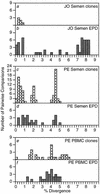Human immunodeficiency virus type 1 populations in blood and semen
- PMID: 9420266
- PMCID: PMC109415
- DOI: 10.1128/JVI.72.1.617-623.1998
Human immunodeficiency virus type 1 populations in blood and semen
Abstract
Transmission of human immunodeficiency virus type 1 (HIV-1) usually results in outgrowth of viruses with macrophage-tropic phenotype and consensus non-syncytium-inducing (NSI) V3 loop sequences, despite the presence of virus with broader host range and the syncytium-inducing (SI) phenotype in the blood of many donors. We examined proviruses in contemporaneous peripheral blood mononuclear cells (PBMC) and non-spermatozoal semen mononuclear cells (NSMC) of five HIV-1-infected individuals to determine if this preferential outgrowth could be due to compartmentalization and thus preferential transmission of viruses of the NSI phenotype from the male genital tract. Phylogenetic reconstructions of approximately 700-bp sequences covering the second constant region through the fifth variable region (C2 to V5) of the viral envelope gene revealed distinct variant populations in the blood versus the semen in two patients with AIDS and in one asymptomatic individual (patient 613), whereas similar variant populations were found in both compartments in two other asymptomatic individuals. Variants with amino acids in the V3 loop that predict the SI phenotype were found in both AIDS patients and in patient 613; however, the distribution of these variants between the two compartments was not consistent. SI variants were found only in the PBMC of one AIDS patient but only in the NSMC of the other, while they were found in both compartments in patient 613. It is therefore unlikely that restriction of SI variants from the male genital tract accounts for the observed NSI transmission bias. Furthermore, no evidence for a semen-specific signature amino acid sequence was detected.
Figures




References
-
- Alkhatib G, Combadiere C, Broder C, Feng Y, Kennedy P E, Murphy P M, Berger E A. CC CKR5: a RANTES, MIP-1a, MIP-1b receptor as a fusion cofactor for macrophage-tropic HIV-1. Science. 1996;272:1955–1958. - PubMed
-
- Anderson D J, Wolff H, Pudney J, Wenhao Z, Martinez A, Mayer K. Second Contraceptive Research and Development (CONRAD) Program International Workshop. New York, N.Y: Wiley-Liss; 1989. Presence of HIV in semen; pp. 167–180.
-
- Ball J K, Holmes E C, Whitwell H, Desselberger U. Genomic variation of human immunodeficiency virus type 1 (HIV-1): molecular analyses of HIV-1 in sequential blood samples and various organs obtained at autopsy. J Gen Virol. 1994;75:67–69. - PubMed
-
- Bellgrau D, Gold D, Selawry H, Moore J, Franzusoff A, Duke R C. A role for CD95 ligand in preventing graft rejection. Nature. 1995;377:630–632. - PubMed
Publication types
MeSH terms
Substances
Associated data
- Actions
- Actions
- Actions
- Actions
- Actions
- Actions
- Actions
- Actions
- Actions
- Actions
- Actions
- Actions
- Actions
- Actions
- Actions
- Actions
- Actions
- Actions
- Actions
- Actions
- Actions
- Actions
- Actions
- Actions
- Actions
- Actions
- Actions
- Actions
- Actions
- Actions
LinkOut - more resources
Full Text Sources
Medical
Molecular Biology Databases
Miscellaneous

